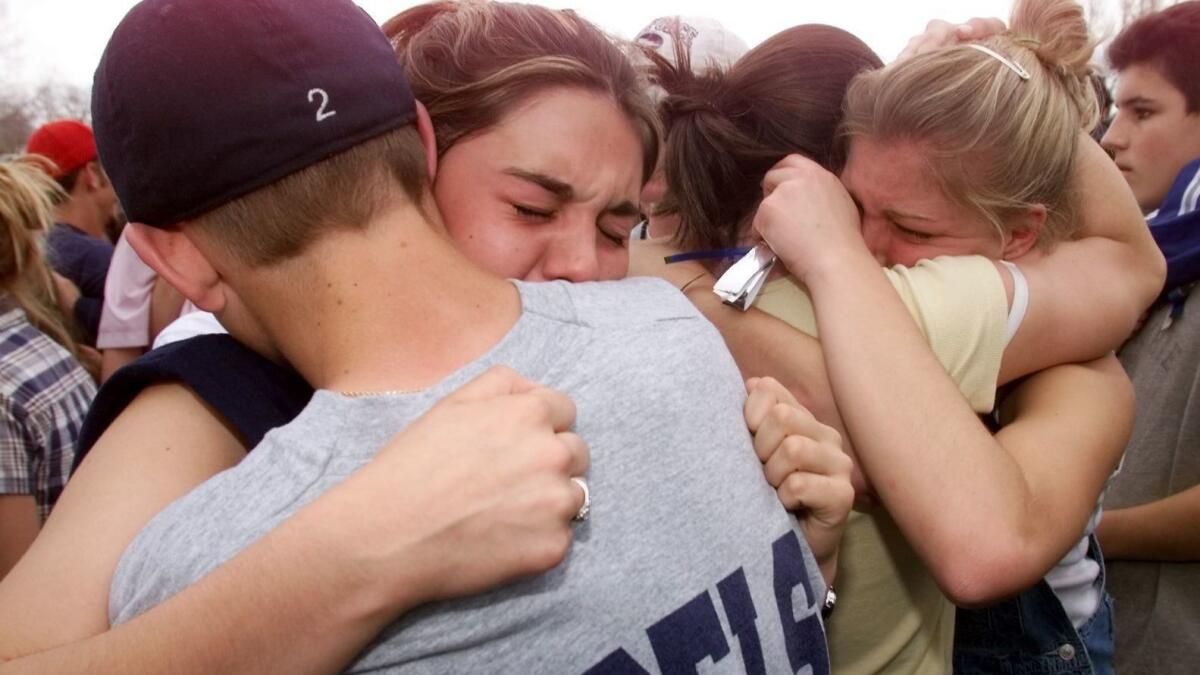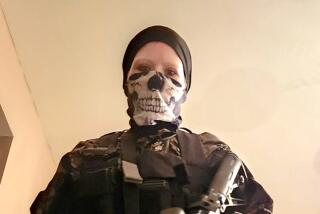Editorial: In the 20 years since Columbine, we have more school security — and more school shootings

- Share via
At about 20 minutes after 11 on the morning of April 20, 1999, students Eric Harris and Dylan Klebold pulled semiautomatic firearms and sawed-off shotguns from beneath their black trench coats and, standing on an elevated part of their Columbine High School campus in suburban Denver, began shooting. Within minutes, 12 students and one teacher were dead or dying and another two dozen people were wounded. As bad as the massacre was, it could have been significantly worse. Large bombs the two high school seniors had left in the crowded cafeteria and in their parked cars failed to go off, as did most of the pipe bombs they tossed as they strode though the campus.
That devastating day at Columbine — 20 years ago Saturday — has come to represent an inflection point in the public consciousness. The word Columbine itself now conjures up all-too-familiar images of troubled youths, weapons, terror and violence, and the massacre has insinuated itself into some still-developing teenage minds as a nihilistic resolution to post-adolescent problems. In a sick yet unsurprising twist, at least 16 Denver-area school districts — including Columbine’s — didn’t open Wednesday as police sought an 18-year-old Miami woman infatuated with Columbine who had traveled to Denver and, upon her arrival Monday, bought a shotgun and ammunition and disappeared. She was found dead Wednesday from an apparent self-inflicted gunshot wound.
While full-scale massacres like the one at Columbine remain rare, school shootings generally are becoming more common and more deadly.
While full-scale massacres like the one at Columbine remain rare, school shootings generally are becoming more common and more deadly. According to statistics maintained by the Naval Postgraduate School, 349 people have died in school shootings since Columbine. Among the most horrific were the killings of 26 people, mostly young children, at Sandy Hook Elementary School in Connecticut and the deaths of 17 people, mostly students, at Marjory Stoneman Douglas High School in Parkland, Fla. After each incident, stunned and fearful school officials across the country began to rethink campus security. But even as they added armed security guards, fences and gates to campuses, locked exterior doors during school hours, and implemented “active shooter” drills for students and staff and more aggressive first-response strategies, more mass school shootings came. In fact, a new study from Ball State University found that investing hundreds of millions of dollars nationwide in security upgrades achieved little more than creating a false sense of safety.
So what are the solutions? Limiting access to firearms and providing better preventive help for troubled students are the obvious ones.
Guns, in particular, lie at the heart of the violence. From the time of the Columbine massacre through 2016, the U.S. manufactured 102 million firearms for domestic consumers (and imported an additional 600,000 guns from overseas gun makers). The industry is protected by the stubborn and cynical National Rifle Assn. and its allies, which make even modest attempts to control access to guns nearly impossible. The nation is awash in firearms, but as a culture, we’re also awash in violence, which we romanticize in movies, television shows and music. Our police amass military-grade equipment as our neighbors build up personal arsenals, and rhetoric over gun control often descends into threats even as our violent crime rates overall have steadily declined.
Enter the Fray: First takes on the news of the minute »
Columbine, of course, bears no responsibility for any of that. In fact, it is a symptom. Such shootings outrage society, but not sufficiently to move the political needle on reforms to combat it. In fact, the opposite has happened: We’ve normalized the experience. When a shooting occurs, advocates for and against gun control unleash prepared rapid-response media blitzes that reinforce their supporters’ existing beliefs, but fail to persuade opponents in what has become a ritualized dance around the graves of the newly dead. It’s as though as a society we have tacitly agreed to live our daily lives under the gun, despite wide popular political support for steps such as universal background checks and red flag laws allowing the confiscation of weapons from people believed by those closest to them to be a risk to themselves or others.
As a nation, we like to view ourselves as the freest society in the world, yet we have more guns and more killings than any other advanced nation, and our solution is to lock our students in their classrooms and arm their teachers. Education in a bunker is not a sane response to this problem. Two decades ago, the nation watched in horror as the unimaginable played out over national television. Now we await the inevitable, having failed, ironically, to have learned much of anything from school lessons delivered in blood.
Follow the Opinion section on Twitter @latimesopinion or Facebook.
More to Read
A cure for the common opinion
Get thought-provoking perspectives with our weekly newsletter.
You may occasionally receive promotional content from the Los Angeles Times.









